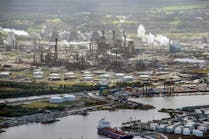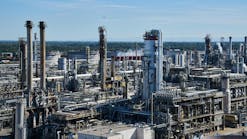Where Myanmar's First Offshore Developments Are Planned (64692 bytes)
Myanmar's first offshore hydrocarbon development will get under way soon.
Led by France's Total, partners in the $1 billion development of Yadana supergiant gas field in the Gulf of Martaban signed gas sales and pipeline agreements this month. That sets in motion work that will lead to supply of gas to neighboring Thailand and potentially Myanmar for 30 years.
The field could hold reserves of more than 5 tcf.
Production is expected to begin in mid-1998, with deliveries scheduled to start at 65 MMcfd by July 1, 1998, and build to 130 MMcfd before plateauing at 525 MMcfd 14 months later. Gas production eventually could reach 650 MMcfd, including volumes intended for Myanmar consumption.
Myanmar's second offshore development, proposed by a unit of Texaco Inc., is the subject of continuing talks over a gas sales agreement.
State owned Myanma Oil & Gas Enterprise (MOGE) on Feb. 2 signed the necessary accords with production sharing contract (PSC) participants Total Myanmar Exploration & Production Ltd., Unocal Myanmar Offshore Co. Ltd., and Petroleum Authority of Thailand Exploration & Production Public Co. Ltd. (Pttep). The accords cover a gas sales agreement calling for supply of gas to Thailand's state petroleum agency and Pttep parent Petroleum Authority of Thailand (PTT).
Earlier that week in Yangon, Total, Unocal, and Pttep agreed to form a transportation company to lay and operate a pipeline that will transport the gas from Yadana to the Thailand border.
A separate sales agreement also was signed in Yangon calling for 125 MMcfd of gas to be supplied to Myanmar. That would first entail laying a separate pipeline from Yadana to landfall south of Yangon, about 320 km north of the field.
Thailand in September 1994 signed a memorandum of understanding with the military junta ruling Myanmar to import Yadana gas in a deal valued at about $500 million/year.
Partners in the pipeline project are Total 36.75/c, Unocal 33.25%, and Pttep 30%. Total operates the field development and pipeline project, and PTT will operate the pipeline on Thai territory.
MOGE holds an option to acquire a 15% interest that could cut other partners' interests proportionately to Total 31.23%, Unocal 28.02%, and Pttep 25.5%. The state energy firm has deferred action on the option, but officials said it will decide by midyear.
Pttep reached agreement in January to acquire a 30% interest in the project, finalizing a joint venture accord with original PSC holders Total and Unocal. That accomplishes the Thai state concern's goal, which was to obtain the maximum equity stake it could in the project as a prerequisite for negotiations over the gas purchase accord parent PTT would sign with Total and Unocal.
PROJECT DETAILS
Plans call for laying a 354 km subsea pipeline across the Gulf of Martaban to landfall in Southwest Myanmar before continuing another 65 km to the Thai border.
Pipelaying is to begin this year after completion of a full evaluation of onshore route options intended to minimize environmental effects. Environmental studies are under way.
PTT will lay and operate a 300 km pipeline leg from the border with Myanmar to a 2.8 million kw, combined cycle, gas fired power plant Electricity Generating Authority of Thailand plans to build at Pilok, Ratchaburi, southern Thailand. The power plant is expected to cost 70 billion baht ($2.8 billion).
Details of the proposed offshore development aren't disclosed. While the agreements refer to Yadana as a single field, earlier indications were of two apparent structures previously referred to as Martaban gas fields.
The first discovery occurred shortly after drilling resumed off Myanmar following a suspended period during 1976-82. The MOC-13A well flowed 39 MMcfd of gas from three middle Miocene limestone reservoirs at 6,3006,700 ft on the 3DA structure.
In the course of drilling another 10 wells - five of which flowed more than 5 MMcfd each - a second structure, 3CA, was delineated and condensate reserves confirmed (OGJ, Jan. 19 1987, p. 62). It isn't clear whether the two apparent structures make up a single giant structure :
U.S engineering consultants DeGolyer & MacNaughton recently certified Yadana's recoverable gas reserves at about 5.8 tcf.
POLITICAL CONTROVERSY
The Yadana project agreement has proceeded amid a great deal of political controversy.
The September agreement between Bangkok and Yangon followed 20 months of painstaking negotiations that ended in August.
International groups opposed to the Yangon junta have attacked the project, claiming it supports the Myanmar government's alleged human rights abuses and could cause environmental damage.
Thai and Myanmar officials claimed in response that foreign exchange earnings from the project, which could spur spending of an additional $1 billion for Myanmar industrial development, will usher in a new economic era and thus contribute to positive political changes in the former British colony, whose current major exports are limited to timber and gemstones.
Thai officials at the time said the gas sales/pipeline accords conform with resolutions adopted at an August 1994 meeting of the Association of South East Asian Nations that called for extending economic support and cooperation to Myanmar intended to help bring it into the world arena.
Thailand is keeping an arm's length stance on the Myanmar side of the project, reflected in its decision to buy Yadana gas at the Thai border. The anti--Yangon Mon and Karen minority groups have threatened to sabotage the proposed onshore pipeline in Myanmar, which will be laid in heavily forested areas. Myanmar has pledged to use military force to ensure the project's security.
At the same time, criticism in Thailand has focused on the purchase price for Yadana gas. Minister of the Prime Minister's Office Savit Bhodivohok said the 1998 price of $3/MMBTU reflects the pipeline delivered cost of the gas. He pegged the wellhead cost for Yadana gas at $1.70/MMBTU, compared with the benchmark price of almost $2/MMBTU for gas produced from Unocal's Erawan gas field in the Gulf of Thailand.
Pttep Pres. Viset Choopiban defended his company's equity investment in the project, saying it provides a fairly good internal rate of return of about 15%
TEXACO PROJECT
Negotiations began last September between Texaco and PTT over long term sales of gas from Texaco's Yetagun gas field.
Texaco discovered the field southeast of Yadana field and 420 km south of Yangon in the Gulf of Martaban in 1992. It drilled two successful wells on Block M-13 in a little more than 100 m of water. Texaco's three blocks in the area have a combined total of 36,200 sq km.
The company's 1 Yetagun discovery well flowed 75 MMcfd of gas and 1,000 b/d of 47.5 gravity condensate from four zones at 1,950-2,195 m. It followed that up with 1 East Yetagun, which flowed 63 MMcfd of gas and 1,922 b/d of 53.5 gravity condensate from three zones at 2,012-2,133 m. Texaco drilled two more wells on the acreage, both dry holes.
MOGE said Texaco plans to conduct a 3D seismic survey in the Yetagun area to get a better estimate of the field's gas reserves. Yetagun gas is said to be of better quality than Yadana's, featuring a high methane content.
TEXACO NEGOTIATIONS
Texaco began talks in September with Thai officials following disclosure of estimates of Yetagun's potential reserves.
MOGE Managing Director Pe Kyi at the time said an initial estimate placed Yetagun reserves at 1.5 tcf.
Thai officials said talks with Myanmar and Texaco focused on potential gas delivery of about 200 MMcfd of gas by about 2000. The gas would be delivered to Thailand through a pipeline to be laid from Yetagun to Thailand's southern peninsula at landfall near Ranong or Krabi. Plans call for laying a pipeline from that point across the peninsula to the Khanom/Nakhon Si Thammarat area, an industrial center based mostly on a downstream oil and gas infrastructure that will be the nucleus of Thailand's multibillion dollar Southern Seaboard Development plan.
Meantime, Pttep wants to acquire an interest in the Yetagun project as part of gas sales agreement negotiations with Texaco and Yangon.
Texaco Exploration Myanmar Inc. is operator of and holds a 50% interest in the PSC covering Blocks M-12, M-13, and M-14. Other interest owners are Premium Petroleum Myanmar 30% and Nippon Oil (Myanmar) Exploration 20%.
Copyright 1995 Oil & Gas Journal. All Rights Reserved.


